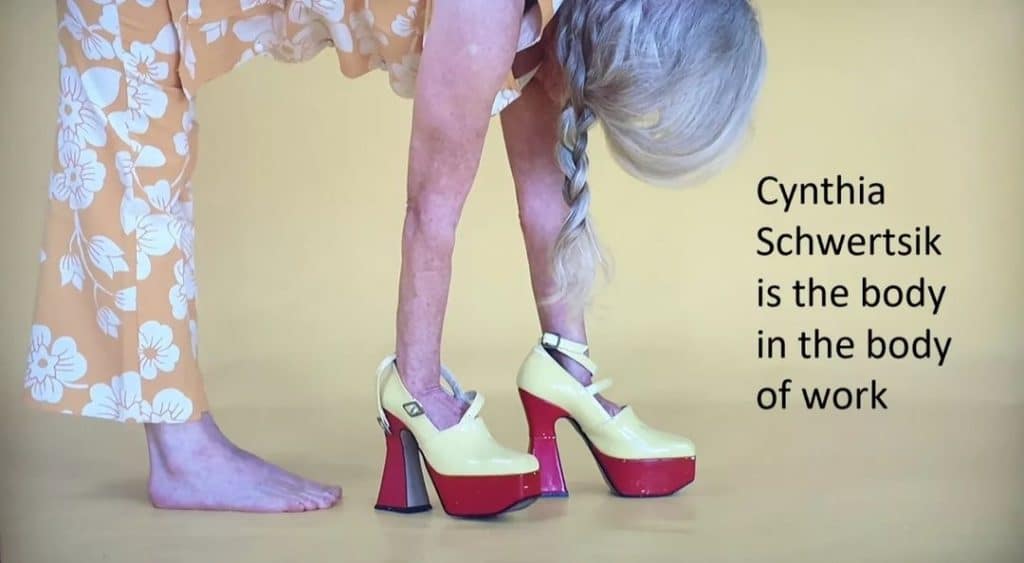
22 Oct An Artist of Movement through Contemporary Landscapes

image: Rosina Possingham
text: Susan Charlton
Cynthia Schwertsik is the body in the body of work
The body traversing the landscape, tracing its faultlines
The body contemplating the archive, registering its enormity
She is here, but not from here – bringing her own histories of country, movement, language and art. This makes her more keenly aware of her status as a visitor – a cultural mindfulness she experiences as an ongoing state of being unSettled. This destabilised position is both a source and driver of her practice, fuelling the questing curiosity and poetic absurdity at the centre of her investigations and expeditions. Schwertsik is alert to Country, specially the boundaries, edges and inbetween spaces of The Occupation.
Her survey show and adjacent photographic and video collaborations with Rosina Possingham at Hahndorf Academy form an annotated archive of works, mostly performed on Kaurna and Peramangk lands in and around Adelaide/Tandanya over the last five years. Her Peri Urban Progress video series recalls the first European explorers, blundering across the land in their efforts to claim and tame it. She constructs strange counter-intuitive devices – part viewing platform, part vehicle – for her obsessive mapping and remapping of territories, casting dystopian silhouettes and shadows as she paves her way. Here she makes use of chairs as symbols of the ‘cultural heritage or colonial ballast we carry with us, both as burden and commodity, to interrogate our relationship with place’.
Schwertsik’s embodied art practice draws from her own background in performance, dance and yoga, as well as the influences of 20th century feminist and action-based, post-object art. Her works often begin with a conjecture, a quandary, a conundrum, a provocation, a befuddlement, which sets her in motion across landscape and public spaces. Works might involve collaboration and exchange, like the ‘coming together to examine the potential of combining forces’ through ‘shared time in conversations’ with artist Dave Laslett. Or ‘We talk about things, then we do things’, as she has described her projects with Rosina Possingham. ‘I don’t think through thinking’, she says, ‘I think through doing’. Schwertsik’s parallel interest to landscape is the archive. She uses her art practice to interrogate accumulation, meaning and value, as well as storytelling, memory and letting go, most notably in her 2021 installation-performance project Bureau d’Exchange, and also in video works such as Headspace and Take up Residence, both on display at Hahndorf Academy. In these pieces the archive looms over our heads in sculpted clouds of information, or imprisons us in our excess. She is often driven to assert a sense of presence, identity and embodiment in the face of the archive, specially the digital archive, by using charcoal on paper to map her face into roughly hewn artefacts and portraits of self.
The exhibition’s very title, How to Exit a Reality, in 7 Chapters, seems to imply a desire to escape from the overwhelm of the archive by any means necessary, including through the incineration of chairs and archival constructions from previous works in Exit #1 and Exit #2; the burial of Possingham’s stash of Invisalign retainers in Exit #5; and the abandonment of her wedding shoes – the glam stars of the recent Schwertsik-Possingham collaborations. Amidst all the action at play within the exhibition, a major work presides over the mise-en-scene, gesturing towards a quiet, though precarious, resolution to this body of work. In Tableau Vivant, a collaboration with Dave Laslett on Adnyamathanha country, Schwertsik is poised delicately in a chair suspended on high from a most magnificent, glistening gum tree. She is cloaked in an old kangaroo skin coat with fox fur trim and wearing genteel ladies’ lace-up boots, reading from a large, red, leather-bound book. All around is dark. It is the stuff of European fairy tales … transposed onto Country. At the base of the image in the gallery are two scorched, melted plastic chairs, survivors of the fires of the summer of 2019-20 in the Adelaide Hills, where the artist lives. The whole tableau is a perfect representation of Cynthia Schwertsik as the body in the body of work, the body traversing landscape, the body contemplating the archive. As she has observed of her artmaking process, ‘I look into the archive of my own work up to this point to get to the essence of what actually drives me and gives me direction’. How to Exit a Reality sets the stage for further chapters and directions in this compelling storytelling journey.



No Comments